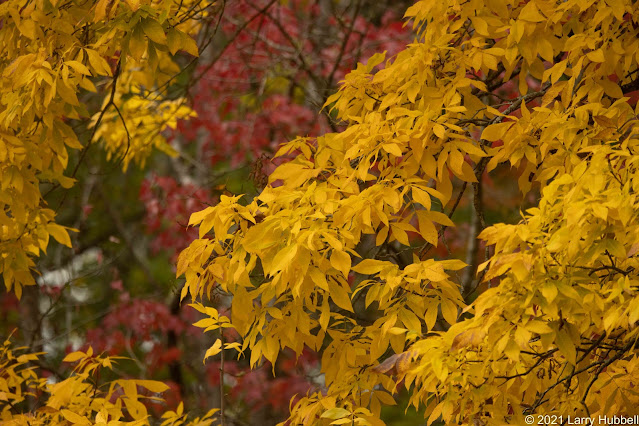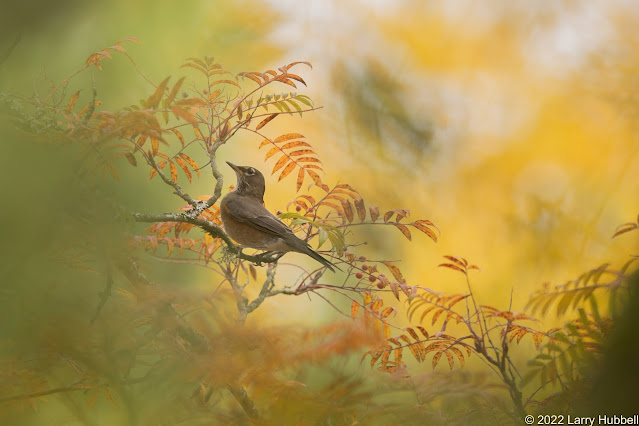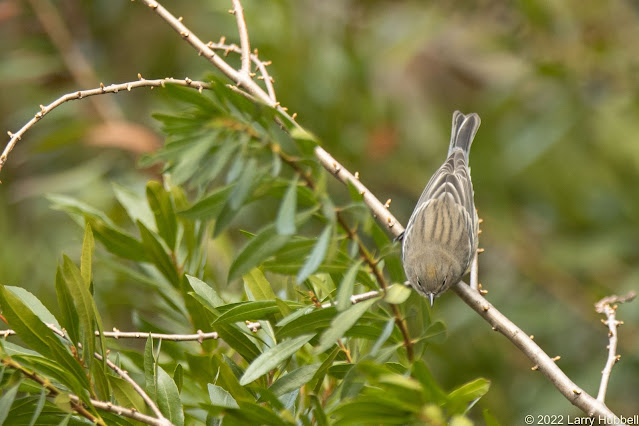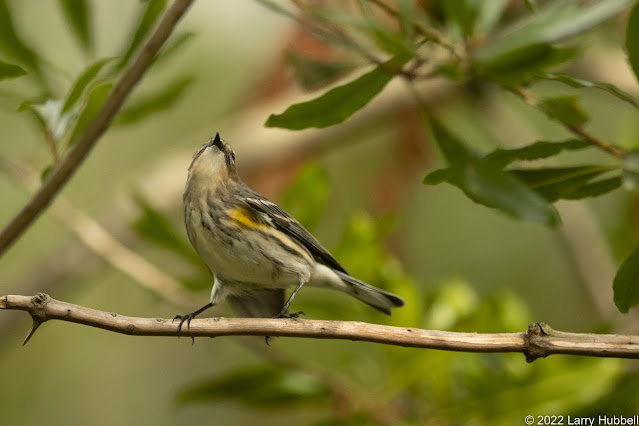It is almost Winter. The days are short and gray. The flowers and much of the green growth of Spring are gone. What's left of our native fruit is mostly past its prime. This is the time when the beauty of nature can provide a truly heartwarming boost.
The red waxy tips, on their inner wing feathers, inspired the last name of the Cedar Waxwings.
A female American Robin is a surprisingly beautiful bird. Her head and back are similar in color to a Waxwing, the white and dark streaks on her throat and the broken white eye-rings create wonderful contrasting highlights. Best of all her breast is a subtle shade of russet-orange that may be the most beautiful hue on a color wheel.
The glowing display of the last lingering leaves is another wonderful aspect of winter beauty.
By the way, in my previous post, there is a new update regarding Varied Thrush. My friend Etta kindly reminded me that Varied Thrush do not breed in urban areas. This is also documented in BirdWeb our local, free, online birding application from Seattle Audubon.
Last week, this tiny Hermit Thrush attracted my attention, as it searched for food on this moss-covered support for the Wilcox walking bridge, in the Arboretum.
When it flew, it landed nearby in this leafless tree. The Hermit Thrush was clearly focusing its attention on the little pink spheres.
Its feeding strategy, i.e. fluttering up, and seizing the food while hovering in mid-air, seemed somewhat extravagant. I wondered, What was attracting this exceptional attention?
When I looked more closely, my confusion increased. I wondered, What is this? Is it a fruit, flower, or seed? Are the outer pink parts edible? How much of this do the birds eat?
After repeated trips, I documented one of the larger and calmer Varied Thrush as it sat and pulled out the inner reddish-orange part. Plus, as I looked closer, I realized that the empty pink "husks" were being left hanging on the tree.
Online, I found websites like this one, that solved the mystery. The pink unit as a whole is the fruit of the Spindle tree. The pink parts open up to reveal its orange seeds. On a cautionary note, this tree and its fruit are poisonous to humans, but it does not seem to bother our local Thrush.
The other mystery about this tree is how it got its name. It is called a Spindle tree because historically its durable wood was carved into spindles for spinning wool into yarn.

Mallards are another common bird whose beauty can be easily overlooked. In early Winter, the males are adorned in a fresh set of feathers. Its beautiful new breeding plumage will hopefully attract a mate. The blue speculum, at some angles, looks purple, and it is often hidden by the bird's outer wing feathers.
We also tend to overlook female Hooded Mergansers, partly, because of the way their subtle coloring blends with the world around them.
But also, because the more extravagant males, with their contrasting colors and flashy mating behaviors, easily attract our attention.
The male Wood Duck has a beauty we see year-round, however with such a variety of colors, we tend to overlook the blue highlights on its back. I believe these are from the secondary feathers in its folded wings.
Another beautiful duck, that we usually see only during the colder months, is the Northern Pintail.
Year-round we can find Red-winged Blackbirds. Early in their lives, the males wear basic brown like the females. However, there is a window of time in their first year when the tips of their mature black feathers still retain beautiful youthful highlights of beige and brown.
This time of year, male Northern Shovelers tend to have dark green heads while still having a few dark crescents from their non-breeding plumage on their chests. Their rich chestnut sides do an excellent job of offsetting the bright green of their speculums.
Monty and Marsha, our local Montlake Cut Bald Eagles, have bright yellow bills that blend perfectly with the Fall leaves in their favorite cottonwood tree.
Just to the north, mated pairs of the elegant Trumpeter Swans, calmly dip and feed on the aquatic vegetation below Union Bay. We are lucky to live near a bay that is shallow enough to have vegetation and yet deep enough, and south enough, to not freeze in Winter.
However, for me, one of the most heart-warming sights this week was repeatedly seeing this Wilson's Snipe and watching it bobbing its body up and down, while totally confident in its awesome camouflage.
Have a great day on Union Bay...where nature lives in the city and Black Birders are welcome!
Sincerely,
Larry
Going Native:
Each of us, who breathes the air, drinks water, and eats food should be helping to protect our environment. Local efforts are most effective and sustainable. Native plants and trees encourage the largest diversity of lifeforms because of their long intertwined history with our local environment and native creatures. Even the microbes in the soil are native to each local landscape.
I hope we can inspire ourselves, our neighbors, and local businesses to respect native flora and support native wildlife at every opportunity. I have learned that our most logical approach to native trees and plants (in order of priority) should be to:
1) Learn and leave established native flora undisturbed.
2) Remove invasive species and then wait to see if native plants begin to grow without assistance. (When native plants start on their own, then these plants or trees are likely the most appropriate flora for the habitat.)
3) Scatter seeds from nearby native plants in a similar habitat.
4) If you feel you must add a new plant then select a native plant while considering how the plant fits with the specific habitat and understanding the plant's logical place in the normal succession of native plants.
***************
My friend Elaine Chuang shared several resources (that were new to me) from the January 2022 Washington Ornithological Society meeting. By the way, Elaine credits Vicki King for researching and supplying this information. Keystone native plants are an important new idea. Douglas Tallamy in the book "Nature's Best Hope " explains that caterpillars supply more energy to birds than any other plant eater. He also mentions that 14% of our native plants, i.e. Keystone Plants, provide food for 90% of our caterpillars. This unique subset of native plants and trees enables critical moths, butterflies, and caterpillars that in turn provide food for the great majority of birds, especially during the breeding season.
Here are the top two relevant links.
A video all about native keystone plants for wildlife:
https://www.youtube.com/watch?v=O5cXccWx030
New! Updated resources for adding keystone native plants to your yard.
https://wos.org/wos-wp/wp-content/uploads/2022/10/Native-Plant-Resources-10-7-22.pdf
This updated collection includes a variety of new and different books, perspectives, and interactions between plants, birds, and insects. Thank you to Vicki King for continuing to collect all of these exceptionally helpful works. Also, thank you to each of the individuals who contributed.
***************
In the area below it is my intention to display at least one photo each week to help challenge us to know the difference between native and non-native lifeforms.
1)
2)
3)
These three trees are non-native, deciduous conifers that can be found in the Arboretum. Every year, when the weather turns cold, they lose their needles and look like they are dying, but they are not. In alphabetical order they are:
Your challenge is to associate the appropriate photo number with the correct letter and name.
Scroll down for the answer.
******************
The answers are:
Curiously, The Bald Cypress is the only one that originated in North America. It comes from the S.E. portion of the United States. The Dawn Redwood comes from China. It's only two living relatives come from California. However, our North American Redwoods are not deciduous conifers. The Japanese Larch obviously comes from Japan, but it has a nearby Pacific Northwest relative in Washington State, i.e. the Western Larch, which is a deciduous conifer. Nature is just one mystery inside of another.
The Dawn Redwood photo, in the prior set, is from November. If you go looking for that tree today you would find it has already lost its needles and its foliage looks like this photo. The other two species were photographed this morning.
*****************
The Email Challenge:
Over the years, I have had many readers tell me that Google is no longer sending them email announcements. As of 2021, Google has discontinued the service.
In response, I have set up my own email list. With each post, I will manually send out an announcement. If you would like to be added to my personal email list please send me an email requesting to be added. Something like:
Larry, Please add me to your personal email list.
My email address is:
LDHubbell@comcast.net
Thank you!
*******************
The Comment Challenge:
Another common issue is losing your input while attempting to leave a comment on this blog. Often everything functions fine, however, sometimes people are unable to make it past the robot-detection challenge or maybe it is the lack of a Google account. I am uncertain about the precise issue. Sadly, a person can lose their comment with no recovery recourse. Bottom Line: If you write a long comment, please, copy it before hitting enter. Then, if the comment function fails to record your information, you can send the comment directly to me using email.My email address is:
LDHubbell@comcast.net
Sincerely,
A Final Photo:















































